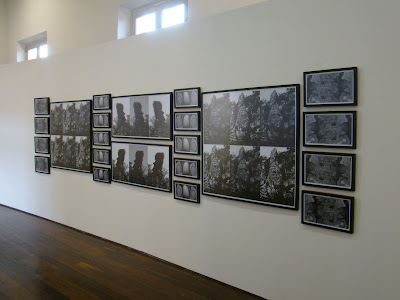Coisas que vi e InVersões
Ludmila Brandão
PhD in Communication and Semiotics, PUC/SP, 1999
Post-doctorate in Cultural Criticism, Unversité d'Ottawa/Canada, 2005
Things I've seen and InVersions by Dan Pelegrin: the work of affections, 2012.
Exhibition Catalog
To think about the works I have selected by Daniel Pellegrim, the Aesthetics (or thinking about art) that suits me is undoubtedly that formulated by the French Gilles Deleuze (1925-1995) and Félix Guattari. Distancing themselves from idealistic aesthetics that favor concepts of beauty, harmony, the sublime, etc., or from the field of signification which, according to Zulmira Tavares' acid criticism, makes the object just a pretext for the game of interpretations, the French propose an aesthetic based on the sophisticated formulation of “sensation”, which is never confused with perceptions and feelings. It is not the eyes (or just the eyes), nor the heart (as the metaphorical organ of feeling), nor thought (or just thought) that generates the encounter with an object/situation of an artistic nature. The body, before any thought, or any cultural overcoding attached to the image, is the direct route to an encounter with art (at least the art that can be understood by this aesthetic), without mediation.
This is why, for the French, the work of art is defined as nothing more and nothing less than a “being of sensation”.
Daniel Pellegrim's works demand this materialistic approach. His works are beings of sensation. And as such, they are objects (beings) that exist on their own, that “stand on their own two feet” (support themselves), and carry the power to act sensitively, in other words, to affect our bodies, to produce sensations that we are incapable of translating. For this reason, what I bring here are not interpretations, they are in fact fabrications about the affects and percepts whose presence I sense, from my body, less than from thought.
In Things I've Seen, what the West has strived to separate, dichotomize and antagonize - man and nature - are confused, returned to the same plane of immanence, beings of the same curious landscape. The scale, which is not Western, is more of an anti-scale that spatially equates the domesticated cerrado in its contour lines with the curves (also contour lines) of a human digital. The frontal and aerial perspectives of the objects photographed are also confused, the combination of which (inversion, sequencing, duplication) makes up a final image that offers us, like Alice in Wonderland, a spatial and genetic paradox.
Finally, the work InVersões, which I particularly like, is made up of a set of 108 photographic images of urban landscapes that have undergone various manipulation processes (blurring, inversion to negative, digital treatment, etc.) and are projected in a loop onto a small block of granite in its raw state, supported by a glass column.
What impacts us, especially affects us, is this trans-temporal encounter between the distant past and the cybernetic present that is evident in this combination of granite, glass and stylized digital images projected onto stone. Contemporary cave inscriptions. The affections of materials and images reorganize the space-time of our lives in such a way that they seem to put us in immediate contact (I couldn't say to what degree) with those who did the hard work of inventing the species, perhaps allowing us an ancestral becoming never before experienced.
________________________________________________________________
Ludmila Brandão
Doutorado em Comunicação e Semiótica, PUC/SP, 1999
Pós-doutorado em Crítica da Cultura pela Unversité d´Ottawa/Canada, 2005
Coisas que vi e InVersões de Dan Pelegrin: o trabalho dos afetos, 2012.
Catálogo da Mostra
Doutorado em Comunicação e Semiótica, PUC/SP, 1999
Pós-doutorado em Crítica da Cultura pela Unversité d´Ottawa/Canada, 2005
Coisas que vi e InVersões de Dan Pelegrin: o trabalho dos afetos, 2012.
Catálogo da Mostra
Daí que para os franceses a obra de arte define-se, nada mais, nada menos, como um “ser de sensação”.
As obras de Daniel Pellegrim exigem essa visada materialista. Suas obras são seres de sensação. E como tais, são objetos (seres) que existem por si mesmo, que “param em pé” (se sustentam por si mesmo), e carregam a potência de atuarem sensivelmente, ou seja, de afetarem nossos corpos, de produzirem sensações as quais somos incapazes de traduzir. Por isso, o que trago aqui não são interpretações, são efetivamente fabulações sobre os afetos e perceptos cuja presença pressinto, a partir do meu corpo, menos que do pensamento.
Em Coisas que vi aquilo que o Ocidente se esforçou por separar, dicotomizar, antagonizar – homem e natureza – são confundidos, devolvidos a um mesmo plano de imanência, seres de uma mesma e curiosa paisagem. A escala que não é a ocidental, é mais uma anti-escala que equipara espacialmente o cerrado domesticado em suas curvas de nível às curvas (de nível também) de uma digital humana. Confundem-se também as perspectivas frontais e aérea dos objetos fotografados, cuja combinação (inversão, seqüenciamento, duplicação) constitui uma imagem final que nos propõe, ao modo de Alice no País das Maravilhas, um paradoxo espacial e genético.
Finalmente, o trabalho InVersões, obra de meu especial apreço, é composta por um conjunto de 108 imagens fotográficas de paisagens urbanas que passaram por variados processos de manipulação (desfocamento, inversão para o negativo, tratamento digital, etc.) e que são projetadas em loop em um pequeno bloco de granito em estado bruto, suportado por uma coluna de vidro.
O que nos impacta, afeta especialmente, é esse encontro transtemporal do passado mais longínquo com o presente cibernético que se evidencia nessa combinação entre granito, vidro, imagens digitais estilizadas projetadas sobre pedra. Inscrições rupestres contemporâneas. Os afetos das matérias e das imagens reorganizam o espaço-tempo de nossas vidas, de tal modo que parecem nos colocar em contato imediato (não saberia dizer em que grau), com aqueles que fizeram o trabalho pesado da invenção da espécie, quiçá permitindo-nos um devir ancestral jamais experimentado.






Comentários
Postar um comentário